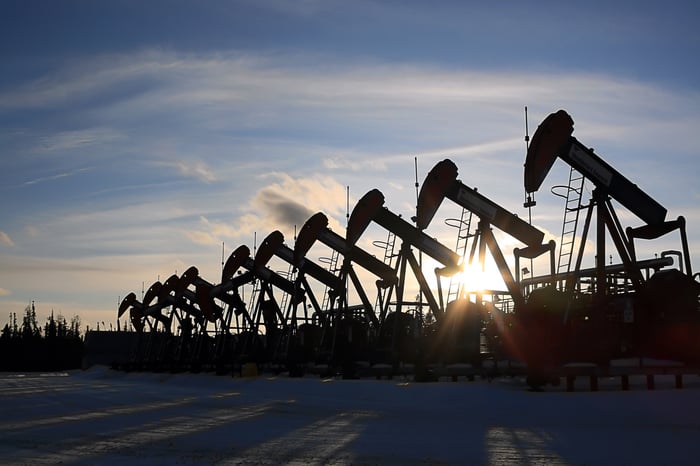ConocoPhillips (COP 1.23%) recently won approval from the Bureau of Land Management for its Greater Mooses Tooth 2 (GMT2) project in the National Petroleum Reserve-Alaska. The company plans to invest $1.5 billion on the project, which could produce up to 40,000 barrels of oil per day (BPD) when it comes on line in 2021. With oil currently around $80 a barrel, that adds up to about $1.7 billion in annual revenue for the oil giant.
It's one of several developments in the state that ConocoPhillips hopes to undertake in the coming years to futher tap Alaska's oil riches. Those projects could pay big dividends for its investors, especially if oil prices remain high.

Image source: Getty Images.
Drilling down into GMT2
ConocoPhillips first filed permits for GMT2 in 2015, which it plans to connect to its Greater Mooses Tooth 1 (GMT1) project by an 8.6-mile pipeline. That project just started producing oil last week, marking the first oil development on federal leases within the National Petroleum Reserve-Alaska.
ConocoPhillips plans to drill 36 wells as part of the initial $1.5 billion GMT2 development plan, and eventually expects to drill 48 there. Even with that massive investment, ConocoPhillips anticipates that oil produced from the facility will have a supply cost of less than $40 a barrel, which means it would make a significant profit if crude prices are still high when it comes on line in a few years. However, given the low production cost, the project should still make lots of money even if oil prices take a hit first.
This project is larger than GMT1. ConocoPhillips invested about $900 million into that facility, drilling 9 wells to start, with plans to eventually drill 33. At its peak, GMT1 should produce around 30,000 BPD.

Image source: Getty Images.
An even bigger prize awaits
GMT2 should turn out to be an excellent long-term investment for ConocoPhillips even if oil prices fall. But an even bigger windfall could be coming down the company's pipeline in Alaska.
In 2016, ConocoPhillips restarted its Alaskan oil-exploration program with its then-partner Anadarko Petroleum (APC). A year later, the companies unveiled the Willow discovery, which they believed held more than 300 million barrels of recoverable oil. That's large enough to support a multibillion-dollar oil hub that could eventually produce 100,000 BPD.
ConocoPhillips now controls this entire prize after Anadarko Petroleum sold its 22% stake to Conoco for $400 million, to give Anadarko cash to buy back shares and pay down debt. ConocoPhillips now believes that Willow and its subsequent discoveries hold between 400 million to 750 million barrels of oil equivalent (BOE) resources. The company estimates it will take an up-front investment of $2 billion to $3 billion over four to five years to prep this site for producing oil. And with a cost of supply below $40 a barrel, the company could reap a huge windfall by tapping into these oil riches, which it hopes to do by 2024.
In addition to the Willow discoveries, which are to the west of GMT2, ConocoPhillips made a couple of finds to the east of that oil-producing region in the Narwhal trend. The company believes it has uncovered another 100 million to 350 million BOE in recoverable oil at those locations. While it still needs to do more appraisal drilling, the proximity to legacy infrastructure could make them attractive commercial opportunities for the company in the future.
Meanwhile, ConocoPhillips has tested only about 25% of the more than 1.6 million acres of drillable land it currently controls in Alaska. Because of that, the company has the potential to continue making needle-moving discoveries as it explores more of its acreage in the state. That would enable it to add to a resource base that currently boasts as much as 3.1 billion barrels of oil in the ground, just waiting to be unlocked.
An oil stock for the long term
ConocoPhillips is one of just a handful of oil companies that have taken advantage of a tax-law change in Alaska to ramp up its investments there. That decision is starting to pay dividends for the company, since it's now able to start another new project and has several compelling discoveries waiting in the wings. That should enable ConocoPhillips to continue growing its production and cash flow in the coming years, giving it more fuel to keep increasing its dividend.




